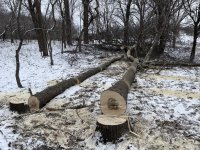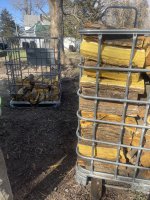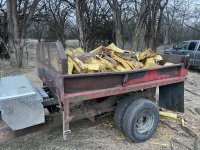You are using an out of date browser. It may not display this or other websites correctly.
You should upgrade or use an alternative browser.
You should upgrade or use an alternative browser.
The 2024 Firewood Thread
- Thread starter Kaptain
- Start date
Yota Up
Dull man
- Joined
- May 20, 2020
- Member Number
- 648
- Messages
- 1,616
Anyone else get bugs in their wood?
A week ago, I brought in some oak from outside for our stove.
Carpenter bees were hibernating inside, and after logs brought into house and warms up, bees wake up and exit hole and proceed to fly around.
This leads to daughter screaming and cats getting excited and me laughing.
I guess only thing to do is wait until I'm ready to put log on and leave them out in the cold rather than prior habit to bring them in and warm them up before going in the stove.
A week ago, I brought in some oak from outside for our stove.
Carpenter bees were hibernating inside, and after logs brought into house and warms up, bees wake up and exit hole and proceed to fly around.
This leads to daughter screaming and cats getting excited and me laughing.
I guess only thing to do is wait until I'm ready to put log on and leave them out in the cold rather than prior habit to bring them in and warm them up before going in the stove.
Muckin_Slusher
****
Closeup of the jack setup, and a pic of the poverty cruiser hauling a load of it.
I should have measured better, I think a shorter hole would have had better geometry, and I could have angled the top in more so the jack wouldn't tend to pop out once the tree started leaning.


I should have measured better, I think a shorter hole would have had better geometry, and I could have angled the top in more so the jack wouldn't tend to pop out once the tree started leaning.
Pony_Driver
Red Skull Member
- Joined
- May 25, 2020
- Member Number
- 1362
- Messages
- 2,172
What kind of sassafras do you have out there? I've never seen one big enough to split.we've burned about 1/2 of our stock this year.
Mostly sassafras and oak. Decided that we'll never split sassafras again. Great to work with, but it doesn't burn hot enough to produce solid heat... It'll be moved to the fire pit stock.
rockota
white collar hillbilly
- Joined
- May 28, 2020
- Member Number
- 1642
- Messages
- 3,959
couldn't tell ya... 🤷What kind of sassafras do you have out there? I've never seen one big enough to split.
budget76
Thread Killer
I bring in one tote thing at a time, which is basically 1-1.5 full loads of the stove depending on how much I burned the last round down. Stack is 15ft from the door, mostly under cover so I just step out in the slippers, load up the bag, and 30 seconds later I'm back inside.Anyone else get bugs in their wood?
A week ago, I brought in some oak from outside for our stove.
Carpenter bees were hibernating inside, and after logs brought into house and warms up, bees wake up and exit hole and proceed to fly around.
This leads to daughter screaming and cats getting excited and me laughing.
I guess only thing to do is wait until I'm ready to put log on and leave them out in the cold rather than prior habit to bring them in and warm them up before going in the stove.
avoids the bug risk that way. I do see people dry like you're talking, I just haven't bothered (and don't really have the setup to do it anyway)
budget76
Thread Killer
oh, and go figure - I've found with my most recent rack reload that smaller splits burn better than big ones, though not as long. Still burning oak, but a different tree and smaller splits, and the stove is much happer. Getting a lot more heat out of it
think it's partially its a little drier, but also that it's breathing better than 3 giant splits were
think it's partially its a little drier, but also that it's breathing better than 3 giant splits were
urjb
Red Skull Member
Saw a guy on YouTube saying he like vegetable oil for bar oil since it’s “eco- friendly” biodegradable hippy dippy..
Any experience with vegetarian oil as bar oil?
I’ve been known to use whatever is around in a pinch, and Grandpa used used motor oil exclusively.
Any experience with vegetarian oil as bar oil?
I’ve been known to use whatever is around in a pinch, and Grandpa used used motor oil exclusively.
WLDWUN
in the woods
I like that even using the jack, you still used the wedges as well. 👍Closeup of the jack setup, and a pic of the poverty cruiser hauling a load of it.
I should have measured better, I think a shorter hole would have had better geometry, and I could have angled the top in more so the jack wouldn't tend to pop out once the tree started leaning.
I have done this many times on larger trees with a strong back lean.
I use a 20 ton stubby jack. I find the shorter the better.
also made an adaptor for the ram to increase its area, otherwise the ram compresses into the wood.
I also agree, make the upper cut rise a little when you make the notch for the jack.
that way it tends to pull the jack into the tree.
the hard part is making sure you leave enough room to get the saw back in the cut without hitting the jack.
if you put a scrap of 1/2 plywood under the jack and use the lower cut to finish, you can avoid that.
Last edited:
[486]
ugh, that guy again?
I just use the used motor oilSaw a guy on YouTube saying he like vegetable oil for bar oil since it’s “eco- friendly” biodegradable hippy dippy..
Any experience with vegetarian oil as bar oil?
I’ve been known to use whatever is around in a pinch, and Grandpa used used motor oil exclusively.
turn the oiler up to max and let it do what it does
WLDWUN
in the woods
Saw a guy on YouTube saying he like vegetable oil for bar oil since it’s “eco- friendly” biodegradable hippy dippy..
Any experience with vegetarian oil as bar oil?
I’ve been known to use whatever is around in a pinch, and Grandpa used used motor oil exclusively.
I was talking to the guys at the local saw shop on bar oil a year or so ago.
they sell ecofriendly bar oil there. It is made from grapes.
I asked who would spend that much for bar oil as it is so much more than normal stuff.
he said companies that cut a lot around water ways use it.
he specifically mentioned one local one called EID
not sure if you have heard of them...

WLDWUN
in the woods
not sure what the purpose of all that cutting was.
would have had the same result if he had just done the top cut, bottom cut and then the back cut.
would have had the same result if he had just done the top cut, bottom cut and then the back cut.
Muckin_Slusher
****
Thanks.I like that even using the jack, you still used the wedges as well. 👍
I have done this many times on larger trees with a strong back lean.
I use a 20 ton stubby jack. I find the shorter the better.
also made an adaptor for the ram to increase its area, otherwise the ram compresses into the wood.

I also agree, make the upper cut rise a little when you make the notch for the jack.
that way it tends to pull the jack into the tree.
the hard part is making sure you leave enough room to get the saw back in the cut without hitting the jack.
if you put a scrap of 1/2 plywood under the jack and use the lower cut to finish, you can avoid that.
The plywood trick is brilliant. Pretty sure I don't need a huge jack for the stuff I do at the lake, biggest I get is about 22 inches across (white spruce or jackpine). I think I'm going to set up a 4 ton jack, since every single tree leans away from shore.
Yarz
Lurker
not sure what the purpose of all that cutting was.
would have had the same result if he had just done the top cut, bottom cut and then the back cut.
In other videos I've seen where they cut like that, the tree got caught in the groove in the stump. They said it was to help keep it from rolling.
Pony_Driver
Red Skull Member
- Joined
- May 25, 2020
- Member Number
- 1362
- Messages
- 2,172
It's for a controlled fall.not sure what the purpose of all that cutting was.
would have had the same result if he had just done the top cut, bottom cut and then the back cut.
dave_dj1
Red Skull Member
A young Amish gentleman bought an old farmhouse on 5 acres near me (two miles away) and had it clear cut. They sold off a few truckloads of firewood logs, no real logs, there was a big pile left and I offered to buy it, we came to an agreement on the price.
I still can't find my pictures!!!!!!!!! HAAAAALLLLLPPPPP!!
ETA: I hauled 7 truckloads of 8'-10' logs home, aprox a cord per trip, I have about two more loads to get, then I will set up my processor that I built and cut/split it up.
ETA2: brought home one more big load this morning, I have about 1/2 to 3/4 of a load to go but it's frozen to the ground, I'll have to run back one day next week when it thaws out.
I still can't find my pictures!!!!!!!!! HAAAAALLLLLPPPPP!!
ETA: I hauled 7 truckloads of 8'-10' logs home, aprox a cord per trip, I have about two more loads to get, then I will set up my processor that I built and cut/split it up.
ETA2: brought home one more big load this morning, I have about 1/2 to 3/4 of a load to go but it's frozen to the ground, I'll have to run back one day next week when it thaws out.
Last edited:
Muckin_Slusher
****
Can you explain the advantage over a traditional open faced notch?It's for a controlled fall.
Muckin_Slusher
****
Found some kind of hydraulic fitting (cap or plug?)
Drilled into it with a 1 inch twist bit to make a domed dimple so it can tilt on the ram a little.
Zip disk waffle pattern into the other side for some traction.
I'll probably have to drill it out bigger when I get a 4 ton jack.
Smallest stubby jack I can find is a 10 ton which seems way overkill for the trees I cut. And they're expensive!



Drilled into it with a 1 inch twist bit to make a domed dimple so it can tilt on the ram a little.
Zip disk waffle pattern into the other side for some traction.
I'll probably have to drill it out bigger when I get a 4 ton jack.
Smallest stubby jack I can find is a 10 ton which seems way overkill for the trees I cut. And they're expensive!
Muckin_Slusher
****
Couldn't pass up this easy dry tree leaning over the ice.
I felled it with an open-face notch, then plunged in behind the hinge and cut back out until the holding wood snapped. You can really hear the snaps. I stop after the first one to back up some and get ready to run.
I felled it with an open-face notch, then plunged in behind the hinge and cut back out until the holding wood snapped. You can really hear the snaps. I stop after the first one to back up some and get ready to run.
Krackle959
Well-known member
Dropped this red oak yesterday, 26” DBH as it was going to be 10’ from the new shop. I’d rather not have it, than have to deal with it after the shop is up. It yielded 3 cord of firewood, and the saw is a 372 with a 24” bar.

Got it all cleaned up and logs in the wood yard.

Got it all cleaned up and logs in the wood yard.
[486]
ugh, that guy again?
got a lathe? they're easy to shorten, so long as you're comfortable with learning how to thread metricSmallest stubby jack I can find is a 10 ton which seems way overkill for the trees I cut. And they're expensive!
be gentle on the gland nut when re-tightening, they're fragile on these little guys
665.0coupe
Red Skull Member
WLDWUN
in the woods
use the jack again yesterday.
I always cut the notch for the jack first. install and put weight on it.
then make my front cuts, and follow that with the back cut.

I always cut the notch for the jack first. install and put weight on it.
then make my front cuts, and follow that with the back cut.
665.0coupe
Red Skull Member
skyhiranger
Well-known member
When we are splitting, we look out for ants, roaches, various other bugs inside the wood. If we see any, they get thrown to the side and not put on the trailer. Then either when we split again we check the buggy wood pile to see if the bugs have moved on, or we grab the buggy wood and it goes straight into the fire as soon as it gets brought into the house.Anyone else get bugs in their wood?
A week ago, I brought in some oak from outside for our stove.
Carpenter bees were hibernating inside, and after logs brought into house and warms up, bees wake up and exit hole and proceed to fly around.
This leads to daughter screaming and cats getting excited and me laughing.
I guess only thing to do is wait until I'm ready to put log on and leave them out in the cold rather than prior habit to bring them in and warm them up before going in the stove.
skyhiranger
Well-known member
23 years ago, when we moved to where we are now, I split everything by hand. We probably burned 2-4ish cords a year at the time. After a few years, I got a splitter. We probably burn 4-6ish cords a year and burn wood exclusively for heat.I'm not as fortunate as some of you to have access to wood. I do have some rounds I need to split, and I've been splitting them with a Splitting maul. It sucks. I am down to about a cord left for this winter. Once spring rolls around, I'll have to find someone to buy a few cords from.
Wife keeps asking when we are going to replace the air source heat pump (since anything below 32* it pretty much just runs on emergency heat (think big ass space heater) and runs almost constantly), because she says she isn't going to split wood for the rest of her life. I keep reminding her how "cheap" it is to burn wood, compared to even running a new efficient heat pump. The only thing we use the heat pump for is AC in the summer.
It is a 1984 vintage Trane heat pump, so I suppose it will die one of these days.


